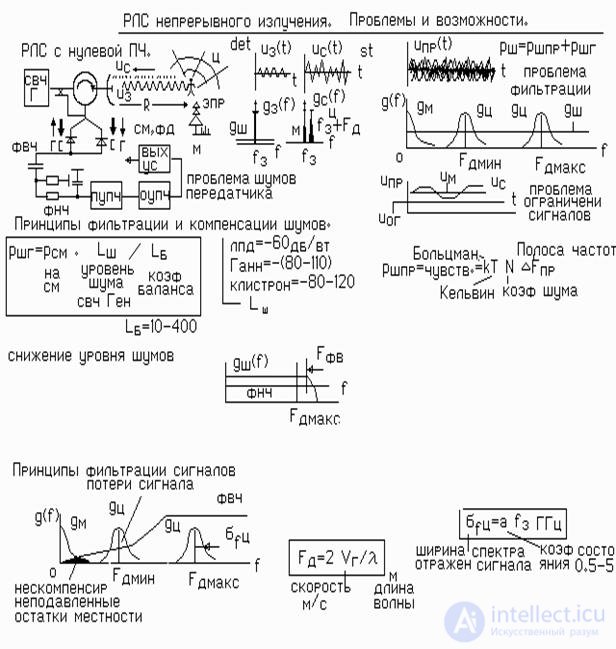
Radar monochrome continuous radiation signals are the simplest and cheapest means. But during their operation and development there are a number of difficulties. The advantages, disadvantages of radars of this class and the problems are discussed in this lecture.
The advantages (simplicity and cheapness) are obvious.
The figure illustrates the operation of a radar of continuous monochrome radiation. From the generator of the microwave transmitter, the probing signal of frequency f 3 is sent through the circulator to the antenna. The reflected signal through the circulator falls on the mixer. There, through the coupler , part of the voltage of the microwave transmitter. The reflected signal has the same frequency as the probe. But its frequency is shifted by the Doppler increment F d. f about = f C + -F d . Of course, passive interference from the terrain does not have Doppler frequencies.
On the mixer, the stochastic reflection signals and the heterodyne voltage are multiplied. And since the local oscillator voltage is constant, linear conversion of signals to the zero intermediate frequency occurs. f be = f s + - F d - f h = F d . Wherein the interference spectrum from the terrain falls on the zero frequency axis, and the spectrum of moving targets shifts relative to zero by the Doppler frequency.
For the radar centimeter range of waves, the magnitude of the frequency F d and the width of the spectra lies in the region of sound frequencies from 0 to 5 kHz. Therefore, the subsequent filtering is carried out cheap sound filters. So the suppression of the terrain is easy to produce using a high-pass sound filter. To reduce the noise level, you can apply a low-pass filter, the frequency “cut” of which is matched with the Doppler frequency of the target moving at maximum speed.
Radar monochrome continuous radiation signals have two significant drawbacks.
1. With the help of a single radar can not measure the distance to the target.
2 Since the transmitter continues to operate in the process of receiving the reflected signal, the transmitter noise reaches the receiver input.
There is a "pumping" of noise. “Inflated” noises add up with the receiver's own noises and can reduce sensitivity by 1–3 orders of magnitude.
At low transmitter powers (up to 10-50 MW), the “pumping” noises can be lower or comparable with the receiver noise. With such powers, the range of the radar can usually be 3-6 km. If you need a range of 20 km or more, the transmitter power should be dramatically increased. But in this case, the “pumping” noises will sharply increase and the range of action practically does not increase!
To increase the range, it is necessary to use low-noise microwave generators and provide special measures to compensate for pumping noise ( circulators , balanced mixers, etc.)


Comments
To leave a comment
Radio Engineering Systems
Terms: Radio Engineering Systems